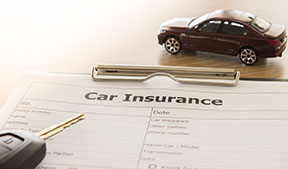

Five Practical Tips for Buying the Right Car Insurance at the Right Price
If you need insurance for a new car or you’ve been routinely renewing your car insurance with the same coverage and limits every year, it makes sense to evaluate your options before buying or renewing. Here are five practical tips:
- When a car is new, you will likely want collision and comprehensive coverage. You’ve made an expensive investment and you want to protect your asset. Not only that but if the car is financed, the lender will require you to insure it. But a few years later, after the loan has been paid off and the car’s resale value has substantially diminished, you may want to compare the cost of collision insurance to the Blue Book value of the car. The closer those numbers get, the more it might make sense to “self-insure” your car for collision. Comprehensive coverage, however, such as loss from fire, flood and theft, usually costs much less than collision and you may well decide to keep that coverage for many more years.
- How many miles do you drive each year? Do you drive to and from work or just for pleasure and convenience? If you only drive a few thousand miles per year, you may want to look into a mileage-based insurance plan. That could save you money.
- Think about the insurance implications of the model of the car you own or will be buying. Obviously if saving on insurance is a big consideration, don’t buy an expensive car with a big engine, like a Maserati. That’s a broad generalization though. To find out which cars probably cost less to insure (and are safer to drive), check out the “Insurance Losses by Make and Model” data published by the Highway Loss Data Institute of the Insurance Institute of Highway Safety: http://www.iihs.org/iihs/topics/insurance-loss-informationThe Mini Cooper Roadster Convertible, for example, has one of the lowest overall collision loss histories. The BMW M6 has one of the worst. Unfortunately, because it takes several years to compile accurate loss data, only information about model years 2005 and older is available. But you can assume that a model’s past loss record is a likely predictor of its future losses — and that insurance companies also make this assumption when calculating auto insurance rates.
- The other tips in this article discuss how you might be able to save money up front. This tip, though, could possibly save you money in the long run. Lots of money. Here’s how:
Nearly every state mandates minimum levels of auto liability coverage. Typical limits are $15,000 per person and $30,000 per accident and $5,000 for physical damage ($15,000/$30,000/$5,000). True, many states have mandated higher limits the last few years, such as $25,000/$50,000/$25,000. These, however, are still not necessarily very high limits depending on the nature of the injuries and the kinds of automobiles involved in an accident.
Should you buy only the minimum limits? Not if your net worth is greater than the minimum limits and not if, in the event of an accident, you don’t want to be held personally responsible for paying the difference between the total amount you are liable for and the limits of your insurance policy. In addition to purchasing higher auto limits, such as $100,000/$250,000/$100,000, many people also purchase umbrella policies that ride on top of these lower limits and provide additional limits of $1 million and more. - Consider how high a deductible you can absorb. If you have good cash flow or a nice rainy day savings fund, you may be able to handle a large deductible. Here’s an example: If you can save $260 a year by raising your collision deductible by $500 (from, say $500 to $1,000) and you don’t think you’ll have an accident more than once every three years, it makes economic sense to take the higher deductible. Otherwise you are trading 3 X $260 = $780 for the insurance company’s $500.
Let us review your auto insurance policies. We’ll ensure you have the coverage you need and may save you money.
Five Practical Tips for Buying the Right Car Insurance at the Right Price
Protecting Your Family from Dog Bite Liability
Do You Know What’s REALLY in Your Homeowners Policy?
The information presented and conclusions within are based upon our best judgment and analysis. It is not guaranteed information and does not necessarily reflect all available data. Web addresses are current at time of publication but subject to change. SmartsPro Marketing and The Insurance 411 do not engage in the solicitation, sale or management of securities or investments, nor does it make any recommendations on securities or investments. This material may not be quoted or reproduced in any form without publisher’s permission. All rights reserved. ©2015 The Insurance 411. Tel. 877-762-7877. www.theinsurance411.com